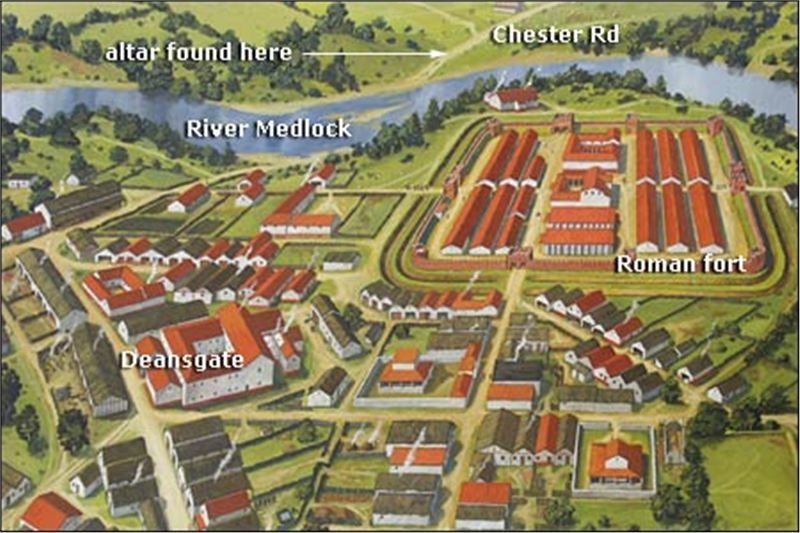Poignant Roman fragment dates from 200 AD
THIS poor neglected lump of Castlefield masonry fenced in under a railway arch is as old as it gets in Manchester. It dates from around 200 AD and is thus around a thousand years older than any other masonry in the city.
It’s a real Roman survivor too. It is one of six features in Manchester on the Schedule of Monuments kept by the Secretary of State for Digital, Culture, Media and Sport. Not that you'd guess. This reminder of our distant past is covered in detritus, walled in, fenced off, and utterly neglected.
This scruffy, hoary old fragment is the real deal, laid down by Roman era hands.
It's used to taking hits though. It's survived the abandonment of the fort when the Romans left, the pillaging of the site for building materials for centuries, and it survived the Industrial Revolution, which ran two canals through the old Roman fort site, three railway systems and covered the area with houses, workshops and factories. In particular it survived the construction of the viaduct that carries the Manchester South Junction and Altrincham Railway under which the fragment lies.
However, as 2018 winds down, this venerable remnant at the far end of Collier Street in Castlefield has been revealed in the most inelegant fashion.
A zombie car park has arrived on the site courtesy of SIP where, on a rough patch of land, they have marked out some parking specs. Notices proclaim it to be private land but, hey, they've opened the gates to the site.
Therefore, Confidential (unofficially) invites people to have a wander and gander, maybe spend an intense moment of communion with Manchester's oldest architectural lump. We have no authority to invite people to do this, but sod it, the gates are open, so have a go anyway.
SIP stands for 'Simple Intelligent Parking', or as we say 'Spontaneous Inquisitive Perusing'.
Why is the wall it significant? Well, Manchester begins with the Romans. No record has been found of buildings related to the Setantii branch of the local Brigantes tribe that occupied this area so it must have been the cohorts of XXth Valeria Victrix legion, under General Agricola, who spotted Manchester's potential in 79 AD.
In particular they recognised the strategic value of the rounded bluff over the confluence of the Rivers Irwell and Medlock and named it Mamucium or 'breast shaped hill'.
The Romans stayed for over three centuries. Their fort was garrisoned, at its peak, by an 800 strong mixed force of infantry and cavalry. This was an auxiliary regiment, not native Romans, but recruits or conscripts from the other provinces.
Primarily the place was military in character but as often happened outside Roman forts a civilian settlement grew which accommodated the unofficial wives of the soldiers and attracted artisans and craftsmen, who set up furnaces and workshops.
During excavations in the seventies a Christian 'magic square' dating from 175 AD was found. This coded inscription spells the word Paternoster, the opening words of the Lord's Prayer in Latin. It’s the oldest evidence of Christianity in the country.
The Romans chose their site well and Manchester became a transport hub. Seven roads met at the fort, more than at any other site in the North. Future movements of people and resources would, for convenience sake, move along these routes and come directly through Manchester.
Many of the main routes into the city still follow Roman lines – the roads met where Beetham Tower now stands, which explains why it always seems dead ahead on so many key arteries into the city.
Roman authority officially abandoned Britain in 410 AD and eventually the Saxons moved in. The Latin word 'castrum', meaning fort, was twisted into the 'chester' element of the city's name.
The Saxons moved the settlement northwards. They needed a more easily defensible place so they chose the area around the present-day Cathedral, on the sandstone lump above the confluence of the River Irk and River Irwell, where Chetham’s Library and School of Music now sits.
The Saxons also feared the supernatural. The old Roman fortresses and settlements looked like the work of giants to them, impossibly clever and complex.
One of the great English poems and one of the language's earliest is The Ruin (see below) which reflects what the Saxons thought of the remnants of Imperial Rome’s power and authority which they kept encountering.

That fragment of Mamucium that remains under the railway arch has potency.
The reconstruction of Roman fort gates, ditches and walls elsewhere in Castlefield are great fun and valuable in showing off our history, but they are reconstructions. So despite its apparent modesty, this scruffy, hoary old fragment is the real deal, laid down by Roman era hands.
It gives us that link with the ancient past of Manchester. It marks the alpha node of this famous city. And it does this silently and alone, a fort wall imprisoned and hidden behind it's own cheap, recent fortifications.
The Ruin (ninth century Anglo-Saxon poetry fragment)
This masonry is wondrous; fates broke it courtyard pavements were smashed; the work of giants is decaying. Roofs are fallen, ruinous towers, the frosty gate with frost on cement is ravaged, chipped roofs are torn, fallen, undermined by old age. The grasp of the earth possesses the mighty builders, perished and fallen, the hard grasp of earth, until a hundred generations of people have departed. Often this wall, lichen-grey and stained with red, experienced one reign after another, remained standing under storms; the high wide gate has collapsed. Still the masonry endures in winds cut down persisted on__________________ fiercely sharpened________ _________ ______________ she shone_________ _____________g skill ancient work_________ _____________g of crusts of mud turned away spirit mo________yne put together keen-counselled a quick design in rings, a most intelligent one bound the wall with wire brace wondrously together. Bright were the castle buildings, many the bathing-halls, high the abundance of gables, great the noise of the multitude, many a meadhall full of festivity, until Fate the mighty changed that. Far and wide the slain perished, days of pestilence came, death took all the brave men away; their places of war became deserted places, the city decayed. The rebuilders perished, the armies to earth. And so these buildings grow desolate, and this red-curved roof parts from its tiles of the ceiling-vault. The ruin has fallen to the ground broken into mounds, where at one time many a warrior, joyous and ornamented with gold-bright splendour, proud and flushed with wine shone in war-trappings;
Parts of this articles were first published in 2012.













